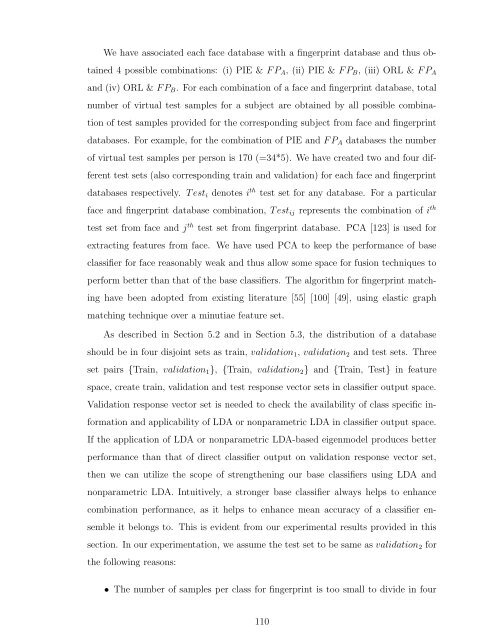Master Thesis - Department of Computer Science
Master Thesis - Department of Computer Science
Master Thesis - Department of Computer Science
You also want an ePaper? Increase the reach of your titles
YUMPU automatically turns print PDFs into web optimized ePapers that Google loves.
We have associated each face database with a fingerprint database and thus ob-<br />
tained 4 possible combinations: (i) PIE & F PA, (ii) PIE & F PB, (iii) ORL & F PA<br />
and (iv) ORL & F PB. For each combination <strong>of</strong> a face and fingerprint database, total<br />
number <strong>of</strong> virtual test samples for a subject are obtained by all possible combina-<br />
tion <strong>of</strong> test samples provided for the corresponding subject from face and fingerprint<br />
databases. For example, for the combination <strong>of</strong> PIE and F PA databases the number<br />
<strong>of</strong> virtual test samples per person is 170 (=34*5). We have created two and four dif-<br />
ferent test sets (also corresponding train and validation) for each face and fingerprint<br />
databases respectively. T esti denotes i th test set for any database. For a particular<br />
face and fingerprint database combination, T estij represents the combination <strong>of</strong> i th<br />
test set from face and j th test set from fingerprint database. PCA [123] is used for<br />
extracting features from face. We have used PCA to keep the performance <strong>of</strong> base<br />
classifier for face reasonably weak and thus allow some space for fusion techniques to<br />
perform better than that <strong>of</strong> the base classifiers. The algorithm for fingerprint match-<br />
ing have been adopted from existing literature [55] [100] [49], using elastic graph<br />
matching technique over a minutiae feature set.<br />
As described in Section 5.2 and in Section 5.3, the distribution <strong>of</strong> a database<br />
should be in four disjoint sets as train, validation1, validation2 and test sets. Three<br />
set pairs {Train, validation1}, {Train, validation2} and {Train, Test} in feature<br />
space, create train, validation and test response vector sets in classifier output space.<br />
Validation response vector set is needed to check the availability <strong>of</strong> class specific in-<br />
formation and applicability <strong>of</strong> LDA or nonparametric LDA in classifier output space.<br />
If the application <strong>of</strong> LDA or nonparametric LDA-based eigenmodel produces better<br />
performance than that <strong>of</strong> direct classifier output on validation response vector set,<br />
then we can utilize the scope <strong>of</strong> strengthening our base classifiers using LDA and<br />
nonparametric LDA. Intuitively, a stronger base classifier always helps to enhance<br />
combination performance, as it helps to enhance mean accuracy <strong>of</strong> a classifier en-<br />
semble it belongs to. This is evident from our experimental results provided in this<br />
section. In our experimentation, we assume the test set to be same as validation2 for<br />
the following reasons:<br />
• The number <strong>of</strong> samples per class for fingerprint is too small to divide in four<br />
110










